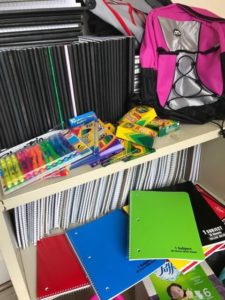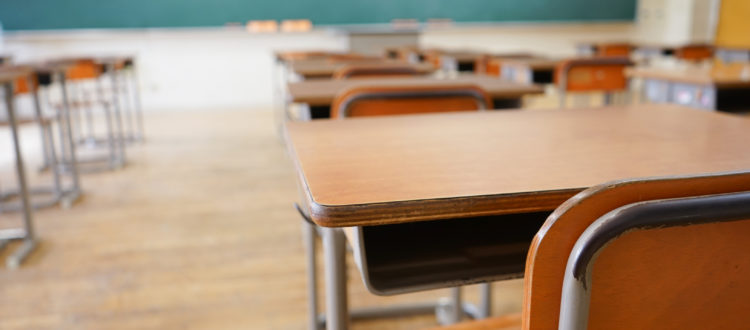How do you do homework when you don’t have a home?
Keeping up with schoolwork is hard enough for kids who have a stable home and enough to eat. For children on the edge of homelessness, it’s a Herculean task.
In Richmond, 38 percent of children live below the poverty line. Many of them are homeless, living in cars, hotels, shelters or with a relative.
“Going to school is a full-time job and it’s hard to take your job seriously when you’re moving around a lot or when you don’t have enough to eat.”
Helping them get to school and stay in school is a problem that impacts the entire community.
 According to the Institute for Children and Poverty, homeless children are nine times more likely to repeat a grade, four times more likely to drop out of school and three times more likely to be placed in special education programs.
According to the Institute for Children and Poverty, homeless children are nine times more likely to repeat a grade, four times more likely to drop out of school and three times more likely to be placed in special education programs.
“Going to school is a full-time job and it’s hard to take your job seriously when you’re moving around a lot or when you don’t have enough to eat,” explained Beth Vann-Turnbull, executive director at Housing Families First. “Plus the stress on their parents filters down onto the children.”
The stress from those children also filters out into the classroom, impacting other students, teachers and families.
Unstable housing
In the Richmond metro area, about 50-60 children and more than 600 adults are homeless on any given night.
But over the course of the year, 3,000 people, many of them children, spend time in one of the city’s homeless shelters.
The disparity in numbers is because homelessness is often a temporary situation, Vann-Turnbull explained. “Unstable housing” is a more exact term for many situations. A family may move in with relatives for a month, then stay in a hotel for a week, move in with friends for a couple weeks, move back to a hotel for a few days, spend a month in a homeless shelter and then end up getting more permanent housing.
“Statistics show that the majority of families aren’t literally homeless – in the streets, a car, or a shelter – for very long,” Vann-Turnbull said.
That’s the good news.
Community impacts
The bad news is that the impact of those homeless months ripples out into the community.
“Not everyone thinks that homelessness affects them if they’re not homeless, but we have students in schools all over the area,” Vann-Turnbull said. “We have them in the city, in the West End, in all of the counties.”
When a child is having academic or behavioral problems in school, it impacts the whole class, she said.
“It’s hard on the child, it’s hard on their classmates, it’s hard on the teachers,” she said. “If there’s a homeless child in your class, you are affected by homelessness whether you know it or not.”
“It’s hard on the child, it’s hard on their classmates, it’s hard on the teachers,” she said. “If there’s a homeless child in your class, you are affected by homelessness whether you know it or not.”
Getting there
And homeless children could be in any school.
The McKinney-Vento Act requires schools to provide transportation and support to homeless students to allow them to stay in their schools even if they aren’t living within the school boundaries anymore.
So if a family loses their home and has to move across town to stay with relatives, or in a hotel or a shelter, the children don’t have to change schools. Their school also has to help them with transportation to and from classes each day.
Generally, Vann-Turnbull said, the school provides gas cards or bus fare so the parents can drive the children to school or put them on a public bus.
Getting the kids to school in the first place is vital, Vann-Turnbull said, but even with assistance, it’s hard. Truancy is a problem for homeless families because it’s difficult to get children across town, even with financial help.
Homeless children are also more likely to miss school because they’re sick.
“Research has found nationally that children in homelessness are sick four times more often than their housed peers at the same income level,” Vann-Turnbull said.
Once they get to school, they need school supplies, which the school systems and Housing Families First help to provide. They also may need academic help and the Henrico County Public School Division provides a tutor who works with all of the Housing Families First students, not only the ones enrolled in Henrico schools.
Breaking the cycle
Hilliard House, the Housing Families First shelter, has 10-20 students at any given time.
“We have children from all over the region,” Vann-Turnbull said. “We have children who have never been homeless before, we have children who have been homeless before, we have high school students who are homeless with babies of their own and we try to help them stay in their own schools and graduate.”
The graduation rates are lower for homeless students and that’s a long-term problem for the poverty rate because graduating from high school is a major factor in future income. Keeping homeless kids in school until they earn their diplomas is the first step to ensuring that their own children don’t grow up in poverty and homelessness.
“Education is the number one factor,” Vann-Turnbull said. “It’s the most important thing we can do for our children.”
Want to help students experiencing homelessness? Donate $25 to fill a backpack with new school supplies or other essentials like shoes, graphing calculators, and headphones.



